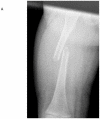Pediatric obesity and traumatic lower-extremity long-bone fracture outcomes
- PMID: 22902734
- PMCID: PMC3748582
- DOI: 10.1097/TA.0b013e31825a78fa
Pediatric obesity and traumatic lower-extremity long-bone fracture outcomes
Abstract
Background: Pediatric obesity is associated with lower-extremity injuries and poor outcomes after blunt trauma. Our aim was to determine if obese pediatric patients with femur and tibia fractures have more severe injury patterns and worse outcomes compared with those of nonobese patients.
Methods: We performed a retrospective cohort study of obese and nonobese pediatric patients with femur or tibia fractures treated at two Level I trauma centers from 2004 to 2010. Patients weighing 95th percentile or greater for age and sex were classified as obese. Patients were compared regarding demographics, Injury Severity Score (ISS), as well as intra-abdominal and orthopedic injuries. Outcomes included fracture treatment, orthopedic complications, intensive care unit and hospital length of stay, ventilator days, and mortality.
Results: Of the 356 patients included in the study, 78 (21.9%) were obese and 278 (78.1%) were nonobese. Obese patients were older (mean [SD], 9.9 [3.7] years vs. 8.8 [3.9] years; p = 0.0162), had a higher ISS (20.8 [13.4] vs. 14.5 [10.8]; p = 0.0002), and sustained more intra-abdominal solid organ (24.4% vs.13.5%; p = 0.0200) and hollow viscus (3.9% vs. 0.0%; p = 0.0105) injuries. They had more pelvic fractures (15.4% vs. 6.9%; p = 0.0196), bilateral tibia fractures (8.0% vs. 0.0%; p = 0.0332), and operatively treated femur fractures (89.9% vs. 79.1%; p = 0.0484). Adjusting for age, obese patients were more likely to be admitted to the intensive care unit (relative risk, 1.68; 95% confidence interval, 1.10-2.55) and die in the hospital (relative risk, 3.45; 95% confidence interval, 1.14-10.41). Adjusting for ISS, these associations were nonsignificant.
Conclusion: Obese patients with femur and tibia fractures have more severe injuries, which may predispose them to greater inpatient morbidity and mortality than do nonobese patients.
Level of evidence: Epidemiologic study, level III.
Figures




References
-
- Ogden CL, Carroll MD, Curtin LR, Lamb MM, et al. Prevalence of high body mass index in US children and adolescents, 2007-2008. JAMA. 2010;303(3):242–249. - PubMed
-
- Dietz WH. Health consequences of obesity in youth: childhood predictors of adult disease. Pediatrics. 1998;101(3 Pt 2):518–525. - PubMed
-
- Chan G, Chen CT. Musculoskeletal effects of obesity. Curr. Opin. Pediatr. 2009;21(1):65–70. - PubMed
-
- Valadka S, Poenaru D, Dueck A. Long-term disability after trauma in children. J. Pediatr. Surg. 2000;35(5):684–687. - PubMed
Publication types
MeSH terms
Grants and funding
LinkOut - more resources
Full Text Sources
Medical
Research Materials

